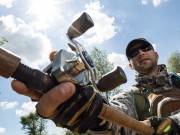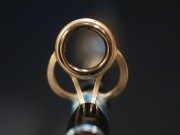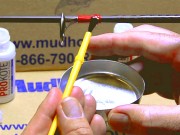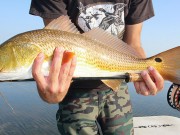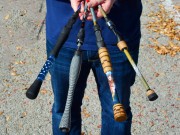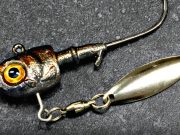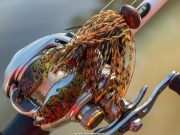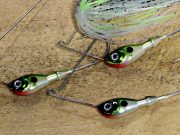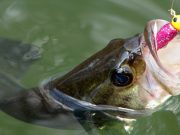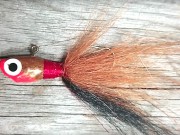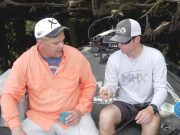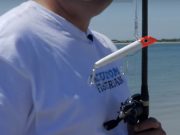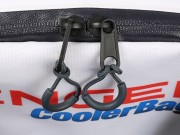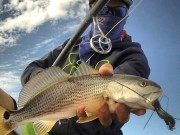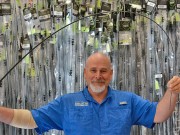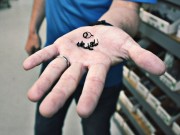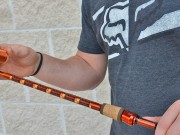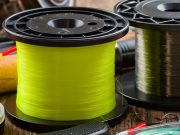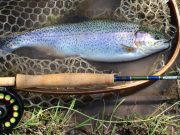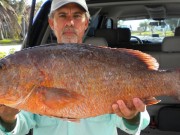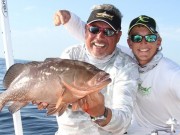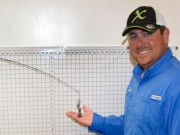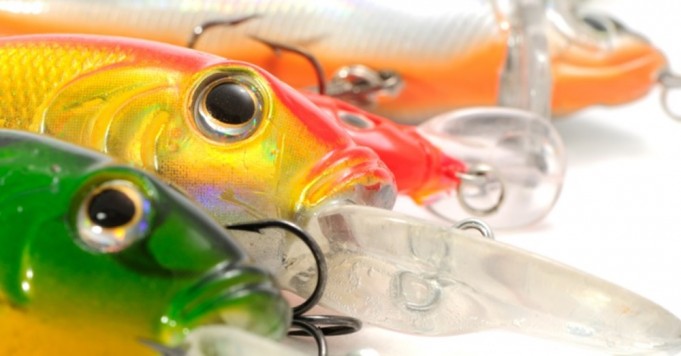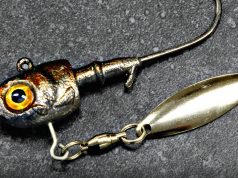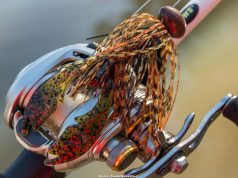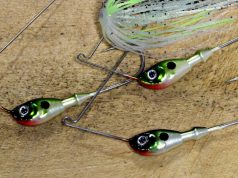To create a truly effective crankbait, tackle makers must carefully consider all of the aspects that affect the lure and balance them into one successful design.
Following is a list of the characteristics lure makers should consider when designing crankbaits (in no particular order):
1. Body Material
When selecting the material for the body of a crankbait, lure makers consider factors like water-resistance, buoyancy, cost, and shaping ability. Most commercial lures are made from injected plastic because it is cheap, water-resistant, consistently shaped, and easy to finish.
This is unfortunate because wooden lures typically produce better action and buoyancy than plastics and are far more durable. Fortunately, there are still some manufacturers that use wooden bodies.
These bodies are typically made from Jelutong, Sugar Pine, Balsa, Basswood, or Cedar. Of these woods, sugar pine, cedar, and jelutong are generally considered the best for lure making, with balsa and basswood coming in a close second.
2. Body Shape and Size
The shape and size of a crankbait affects its action, water displacement, profile, and overall ability to catch fish. Crankbait designers must take both the target species and the laws of physics into consideration when shaping a body.
Well-designed bodies will have a profile similar in shape and size to the target species’ natural prey and will have consciously designed hydrodynamic properties – which determine how the lure interacts with and travels through water.
In a nutshell, curved body designs create gentle movement in the lure, while sharp angles produce violent amplified action.
3. Body Weight & Buoyancy
This trait determines whether the lure will float, sink, or suspend in water. The buoyancy of a lure body can easily be calculated by dividing its density (in grams per cubic centimeter) by the density of pure water (one gram per cubic centimeter).
Sorry for the math. You can probably just “Google” the material you plan to use and get the buoyancy calculated for you.
Lures with buoyancy greater than 1 will sink and lures with buoyancy less than 1 will float. If a lure has buoyancy equal to 1, it will suspend, meaning that it will remain at a specific depth without floating or sinking.
As a point of reference, balsa wood has a buoyancy of 0.17, basswood has a buoyancy of 0.37, jelutong has a buoyancy of 0.46, sugar pine has a buoyancy of 0.36, and cedar has a buoyancy of 0.40.
This means that balsa crankbaits will rise faster and will sit higher on the water’s surface whereas sugar pine, jelutong, and cedar lures will have the more desirable slower ascent and will sit deeper on the water’s surface. Of course, all of this can be modified by adding weights, hardware, and hooks to increase the lure’s weight.
Also, keep in mind that many woods will absorb water and lose buoyancy if they are not sealed properly or if the lure finish is damaged.
Related reading: 4 Types Of Crankbaits That Catch Fish
4. Lip Size and Shape
The shape of the lip affects the diving depth, the wiggle (‘action’), and the lure’s ability to safely bounce off underwater obstacles. The more surface area, the more water the lip will catch and the deeper it will run.
One way that to think of this is to imagine the lip is a canoe paddle. If you try to paddle a canoe with a yardstick, you won’t get very far. This is because the yardstick’s skinny profile has very little surface area compared to the large canoe to push against the water.
On the flip side, if you try to move the canoe with a paddle, you will move very fast. This is because the paddle is wide and long and has more surface area – thus it can “displace” more of water.
Now, if we bring this concept back to crankbait lips, we see that the lips behave in a similar fashion: skinny lips don’t move as much water and thus don’t dive as deep.
Wide lips with more surface area displace much more water and dive much deeper. Assuming we have adequate surface area, the next factor to consider is the lip’s shape.
Rectangular lips basically displace the water equally to both sides and the lure will dive and retrieve straight (assuming it is tuned properly) without much wiggle. Unfortunately, when it hits an obstacle, it will “bounce” back and disrupt the lure’s natural appearance.
Use these in deep diving lures that aren’t likely to hit many obstacles.
Round lures displace water equally to both sides, but they displace different amounts of water at different points on the curve. The end of the round lip has very little surface area and doesn’t move much water and the middle of the lip is much wider and displaces much more water.
This means that the lure will not dive as deep, but will have a wider and slower wiggle. Round lips are also excellent at gliding off of obstacles resulting in less disruption during your retrieve.
Triangular lips also do a great job of naturally deflecting off cover without sacrificing much depth. When they hit an obstacle, they typically just tilt and glide past it.

5. Lip Angle
Lips that are connected at a 0 degree diving angle (e.g. they come straight out forward from the nose) dive deepest and have the tightest wiggle. Lips that are connected at a 90 degree diving angle run shallow and have an exaggerated wiggle.
Lips that are connected in the middle of these two positions will have medium wiggle and medium diving depth.
6. Lip Material
Most lips are either aluminum, Lexan, or stainless steel. Each material has its own pro’s and con’s.
Aluminum and stainless steel lips are durable, add flash, produce stronger ultrasonic vibrations, and are easier to “tune” by hand. Unfortunately, they also extend the crankbait’s profile which can negatively affect the lure’s appeal.
Lexan lips are clear and do not affect the bait’s profile, but they cannot be tuned without the assistance of a heat source and they do not emit strong ultrasonic vibrations.
Overall, the Lexan lip’s clear profile makes it the preferred lip of many tackle makers.
7. Line Tie Position
The position of the line tie can seriously affect a crankbait’s action and diving depth. The position of the line tie determines the lip’s “positive diving surface”.
The “positive diving surface” is the area of the lip that is between the line tie and the tip of the lip. The “negative diving surface” is the area of the lip that is between the line tie and the body of the lure.
The greater the positive diving surface, the deeper the bait will dive and the tighter the wiggle. A line tie placed exactly where the lip meets the body will have virtually no wiggle and will run deeper. A line tie placed at the tip of the lip will have a wider wiggle and will not run as deep.
8. Hook Position
The position of the hooks will affect the crankbait’s body position, hookup ratio, balance, and ability to run true. Remember, your hook positions will alter the center of gravity by adding weight to specific portions of the lure. Your crankbait will behave differently depending on where you position this weight.
As a general rule, all hooks should be positioned in-line with your line tie and should be centered on the bottom or back of the lure. The effect of the hook’s weight on the lure increases as the distance between it and the line tie increases, meaning that hooks at the rear of the bait will have a greater effect on the lure’s action that hooks at the front.
Hooks that are not attached in-line with the line tie will not run true.
9. Hook Size
The hook size you select for your crankbaits affects the lure’s ability to remain upright and catch fish. On a crankbait, the hooks act as a type of rudder by adding downward stability to the lure. When compared to the overall size of the lure, large hooks offer more stability than small hooks.
However, if the hook is too large, it will negatively affect the lure’s action by acting as a heavy anchor. The only real way to tell what size hook you need for a crankbait is to experiment. Keep adding different sized hooks until you find one large enough to provide stability and hook fish, but small enough to minimize the anchoring effect.
10. Finish and Paint
Without getting into the actual appearance of the lure, there are some things that lure makers must consider when finishing their lures. Most importantly, lure makers should use a paint that is water resistant and flexible enough to withstand strong strikes and continuous lure vibrations.
Contrary to popular belief, most of the paints available in hardware stores and hobby shops today do not match this description. Although they will work for a while, they will not withstand the stress of continuous use and hard toothy bites.
Your best bet is to use vinyl paints designed specifically for the fishing tackle industry. They are extremely flexible and are engineered to withstand repetitive-use fishing conditions, and they usually come in better lure colors.
Understanding these principles will help you build and fish crankbaits better!



